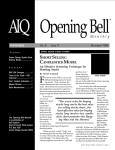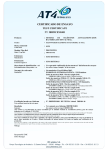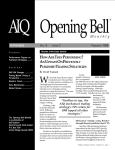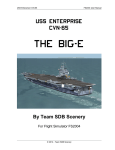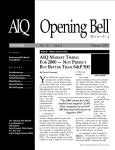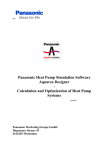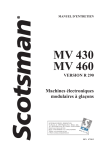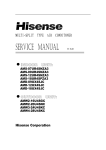Download IMPORTANT! IDENTIFY STOCKS THAT DON`T WORK WELL IN
Transcript
AIQ Opening Bell Monthly IN THIS ISSUE Feature V OL . 10 I SSUE 1 J ANUARY 2001 BEWARE OF TOO MANY STOCKS S ec t i o n s IMPORTANT! IDENTIFY STOCKS THAT DONT WORK WELL IN TRADINGEXPERT Data Maintenance ................ 3 By David Vomund Learn Trend Analysis for Success in Trading .............. 4 T How To Identify and Delete 'Problem' Stocks.................. 1 2000 Market Review ............. 7 S&P 500 Changes ................ 8 Ratings and indicator readings are DAVID VOMUND meaningless. radingExpert comes with a It is important to be able to identify Historical Stock CD that these issues. For technical analysis contains about 10,000 stocks. to work, a stock needs to have a New users often install all 10,000 history of reasonably consistent stocks simply because they are volume. Stocks that trade at very there. This can be a mistake. low volume or We have have frequent found that For technical analysis to zero volume there are only work, a stock needs to have a days provide about 2,000 stocks that history of reasonably consistent inadequate data for the most stockvolume. Stocks that trade at volume based holders might very low volume provide indicators to be willing to inadequate data for the volume give accurate own. Beyond readings. that are stocks based indicators to give The Opening Bell Monthly is a publication of AIQ Systems David Vomund, Chief Analyst P.O. Box 7530 Incline Village, Nevada 89452 Volume is with insuffiaccurate readings. not the only cient volume consideration. or huge bid-toThe price level of a stock is also ask spreads. Installing too many stocks increases your data download important. Low priced and penny stocks often close on either their time, lengthens data maintenance, high or their low prices every day. and lowers the effectiveness of screening reports and Expert Design The closing price from one day to another varies very little in actual Studio models. terms; however, the percentage There are stocks that dont work change can be very large. well in TradingExpert. Their Expert Beware of Too Many Stocks continued on page 2 ® AIQ Opening Bell BEWARE OF TOO MANY STOCKS continued . . . Stocks that dont work well are easy to identify. In Figure 1 we see JPE Inc. (JPEI). The first problem with this stock is its low price of less that $1. Partially because of the low price, the stocks price bars appear blocky. Notice that at the start of the chart all the price bars have the same high price and the same low price. Figure 1 In addition, the stock always closes on either its daily high price or its daily low price. Rarely does the stock close in between its high and low prices. Thats because its closing price is simply its bid or its ask price. When a stock always closes on its high or low value, it will have invalid Money Flow, Volume Accumulation Percent, and On Balance Volume indicators. JPE Inc. has short periods of volume over 100,000 shares but notice that its volume is typically less than 50,000 shares a day. The biggest problem with having stocks like JPE Inc. in your system is that they make the AIQ reports and Expert Design Studio screenings difficult and time consuming to use. In Figure 2 weve run the Weighted Action List report on a database of 10,000 stocks. Notice how many low PLEASE SEND CORRESPONDENCE TO: Opening Bell Monthly G.R. Barbor, Editor P.O. Box 7530 Incline Village, NV 89452 AIQ Opening Bell Monthly does not intend to make trading recommendations, nor do we publish, keep or claim any track records. It is designed as a serious tool to aid investors in their trading decisions through the use of AIQ software and an increased familiarity with technical indicators and trading strategies. AIQ reserves the right to use or edit submissions. For subscription information, phone 1-800-332-2999 or 1-775-831-2999. © 1992-2001, AIQ Systems 2 priced stocks appear on the report. dont work with low price/low volume stocks. Thats not entirely true. It isnt the Expert Ratings that are faulty, it is the indicators that the Expert Ratings are based on that dont work. Most technical indicators wont work with low price/low volume stocks no matter which software package you use. Of the top 10 stocks on the report, all but one have a price less than $2. These are low volume stocks as well. If someone were to use this report hoping to find a good stock, he would have to sift through a bunch of stocks that arent worth analyzIf you are reluctant to delete ing in order to stocks from a large database, find a few stocks that are you can generate AIQ reports worth considonly on stocks with sufficient ering. price and The Weighted Action List isnt the only report that will be dominated by low priced/low volume stocks. Low priced stocks will dominate the top of the Relative Strength report because they went from $1 to $2. Stocks that always close on their high or their low price will dominate the Accumulation/Distribution report. Some say it is a problem that TradingExperts Expert Ratings The low priced stocks can hurt the calculation of industry groups as volume. well. When a stock closes at its bid of $0.25 one day and then closes at its ask of $0.50 the next, then a 100% price gain is factored into its parent group. That makes the group look more bullish than it actually is. If you are reluctant to delete stocks from a large database, you can generate AIQ reports only on stocks with sufficient price and volume. In the Reports module, highlight Stock Reports and right- JANUARY 2001 AIQ Opening Bell BEWARE OF TOO MANY STOCKS continued . . . click the mouse (alternatively, you can click on Reports and then Global Properties). The Global Properties dialog box will appear. To have reports generated only on stocks greater than $10 and volume greater than 200,000 enter 10 next to Price >= and enter 2000 next to Volume >=. Figure 2 If you have installed too many stocks in your database and want to reduce the database size, use the Advanced Ticker Delete function in the Data Manager (see page 64 of the User Manual). If you are installing stocks from the Historical Stock CD, you can use a minimum price and minimum volume filter. Start out with a minimum price of $10 and a minimum volume of 200,000 shares (volume is listed in 100s so enter 2,000 as the minimum volume instead of 200,000). The system will tell you how many stocks pass the test before installing them. If you want more stocks, then loosen the param- eters. Conversely, if you want less stocks then tighten the parameters. The process of installing stocks from the Historical Stock CD is described in the User Manual on page 42. n David Vomund publishes VIS Alert, a weekly investment newsletter. For a sample copy of the newsletter, call (775) 831-1544 or go to www.visalert.com. STOCK DATA MAINTENANCE The following table shows past and future stock splits: Stock U.S. Physical Ther. Sanmina Corp. Home Finl Bancorp Green Mount. Coffee Forest Labs Direct Focus Brinker Intl Ticker USPH SANM HWEN GMCR FRX DFXI EAT Split Approx. Date 2:1 2:1 2:1 2:1 2:1 3:2 3:2 01/08/01 01/09/01 01/11/01 01/12/01 01/12/01 01/16/01 01/17/01 Stock Scholastic Corp. IDEC Pharm. Gallagher (AJ) TALX Corp. Southwest Water Duke Energy Ticker SCHL IDPH AJG TALX SWWC DUK Split Approx. Date 2:1 3:1 2:1 3:2 5:4 2:1 01/17/01 01/18/01 01/19/01 01/22/01 01/22/01 01/29/01 Trading Suspended: Applied Biosystems (ABIO), Biomatrix Inc. (BXM), Cobalt networks (COBT), Cooker Restaurant Corp. (CGR), Florida Progress (FPC), Fort James (FJ), Lilly Industries (LI), MotherNature.com (MTHR), National Discount Brokerages (NDB), Rainforest Café Inc. (RAIN), Seagram Co. (VO), Simpson Ind. (SMPS) Name/Ticker Changes: China Broadband Corp. (CRBC) to China Convergent Corp. (CVNE) CNF Transportation (CNF) to CNF Inc. (CNF), CP&L Energy (CPL) to Progress Energy Inc. (PGN) Flour Corp. (FLR) to Massey Energy (MEE), PE Corp. (PEB) to Applera Corp-Applied Biosystems (ABI) Sybron Intl (SYB) to Apocent Technologies (AOT) JANUARY 2001 3 AIQ Opening Bell TREND ANALYSIS LEARN TO IDENTIFY TRENDS TO FIND VALID STOCKS AND COMMODITIES POSITIONS By Bobby Florez Editor: Edward Robert Bobby Florez, a financial professional for almost three decades, retired from the Chicago Board of Trade in 1996 and now devotes his time to helping others learn how to trade. In the October and November 2000 issues of the Opening Bell, Mr. Florez discussed the basics of futures and how futures can give a perspective of financial trends. In this issue, he covers analysis methods to identify valid trading positions for both stocks and commodities. are the first to get out when the trend or theme has been overplayed or has served its purpose. Two Kinds of Trends There are two kinds of trends lateral and angular. And there are two kinds of angular trends up and down. In Figure 3 we see a bar chart of the Dow Jones Industrial Average. Notice how the Dow swings in a noticeably wide yet precise trading range since the middle of April. upper and lower boundaries of resistance and support there were many up and down swings, or angular trends, each one lasting for at least a week. Although a lateral trend may stretch sideways for weeks or even months, you will always be able to identify minor up and down swings within the confines of the lateral trend. As long as the lateral trend remains in place, the strength of these up and down swings is considerably less than the power of the lateral movement. HowConsider its tendency to want Important to Identify Trends to hold above 10,112 (support) and ever, if the strength of one of these and Themes swings becomes greater than the below 11,880 (resistance). It lateral trends power, Those new to trading then it will break through should gain market the trading range in either experience by examining Knowledgeable, successful traders are an up or down direction. the markets that interest always the first to take positions at the them. In doing so, they Looking again at onset of an identifiable trend or theme. Figure should learn to identify 3, the upper Conversely, they are the first to get out boundaries of the Dows the kinds of trends that compose those markets. trading range was broken when the trend or theme has been Trends are among the first overplayed or has served its purpose. in August. At that time, things you should study an up swing with enough and comprehend. strength behind it broke wasnt until August that a success- through the resistance level at Trends are almost always ful upside penetration (breakout) about 11,880. The Dow moved associated with some well-publiof the resistance level at 10,880 higher for several weeks after the cized theme. If one looks at any occurred. Thereafter, for a few breakout. kind of social or cultural trend, be weeks, the market successfully it fashion, food, transportation, Incidentally, at this time tested its all-time record high advertising, or even politics, there another trading range of greater above 11,520 in early April. is always a thematic tone associmagnitude and power than the Lateral trends are very imporated with it. Shrewd and successone we have been reviewing was tant market phenomena for tradful people are quick to identify becoming apparent. The top, or ers and analysts to pay attention and act upon these themes and resistance level, of this trading to. The lateral trend, or trading trends. range is the all-time record high of range, is the womb from which a the Dow Jones Industrial Average, Themes and trends abound in majority of up and down trends which was set in April of this year. the markets and being able to usually come. identify them is very important. In Figure 3, we see that the This action, which we have Knowledgeable, successful traders ability of the overall trend to identified since April in the Dow are always the first to take posicontain any rally is greater than tions at the onset of an identifiable Jones Industrial Average, is called the power of minor uptrends a major lateral trend. Within its trend or theme. Conversely, they i.e., the lateral trend is of greater 4 JANUARY 2001 AIQ Opening Bell TREND ANALYSIS continued . . . magnitude and power than the minor up and down swings. Figure 3 Recognizing Trends A market is likely to reverse its trend at or about the old support or resistance levels. After reversing, it swings towards the opposing side of the trading range. This leads us to two important trading rules: Always take profits, no matter how small, the first time a previously identified support or resistance point is tested. Profits can be taken the second, third, or fourth time that they are tested as well. Never anticipate breakouts! You should always wait for the actual break of the lateral trend. These rules sound simple but the majority of traders do just the opposite. They would rather wait and see what the market will do rather than exit their positions whenever a market tests a key support or resistance point. Or, they initiate a position in anticipation of either an upside or downside breakout of the market from its prevailing trading range. Trading within lateral trends is difficult and only for short-term traders. A simpler method of making money is to play the breakouts from the lateral trends. The Definitive Trend: A Position Entry & Exit Signal If a market is trending up, it Figure 4 will trend in higher up swings and higher down swings. For down trending markets, the market will make lower down swings and lower up swings. Whenever a market violates its last corrective swing in its prevailing trend, it is an indication that the trend may be changing. You must be prepared to act if the prevailing trend does not resurrect itself right away. I can reveal countless examples of major trends that began when a definitive trend violation like this occurred. The S&P 500 On Friday July 17, the S&P 500 made what appeared to be an upside breakout from a torturous month long lateral trend, Figure 4. However, instead of maintaining its upward momentum, it abruptly reversed. The question to ask when viewing price activity at the time of a breakout is: what is the precise position risk? To answer Trend Analysis continued on page 6 JANUARY 2001 5 AIQ Opening Bell TREND ANALYSIS continued . . . that question, lets recount the activity from July 17, the day the market actually attempted to break out. Figure 5 Notice that on July 19, two trading days after breakout, the market incurred a normal downside reaction. The next day, the market rallied and attempted to resume its upward trend. But this rally lasted only one day. Thereafter, not only did the market fail to rally and regain its up trending momentum and make another new up swing above the July 17 high, but it also declined below the last down swing that occurred on July 19. Thus, in one fell-swoop, the market gave two negative signals. These were signals that would have prevented the bullish but prudent trader from maintaining or initiating any bullish strategies. Once the market broke below its previous lows, professional and institutional traders were not only dumping shares from their portfolios, they were probably also initiating bearish trading strategies. Traders who neglected these signals were subject to a profound plunge in the market and a resounding deflation of buying power in their portfolios. The purpose of the point we are making is to encourage you to pay attention to the markets trend its definitive trend. If you do, you will always be able to fix your position risk at an objective point no matter what market you trade. And you can do this before actually taking a position in the market. For example, lets say that you wanted to buy a stock index future but wanted to limit your risk exposure in case the market reversed its trend. Where would you place your protective sell 6 stop? An objective stop could be placed just below its last down swing. You would not want to maintain any bullish positions below that point. In other words you should not maintain any bullish posture in this market if the last down swing is broken by any future down swing. the July 11 level. When you look at the price differential where the market is compared to its last down swing, you may get cold feet because the difference may be more than what you want to risk. If its more than you want to risk then you probably wouldnt take a position, which is in itself a natural mechanism of risk control.. Day Trading With this analysis, you have automatically and without much conjecture, let the protocol of the definitive trend determine what your action should be in accord with your personal sense of risk. We might add here that had you taken a long position on or around July 17, your stop should have been moved up to the level of the last down swing on July 19, from To be successful with shortterm-trading, it is important to make daily observations and make daily adjustments to your positions when needed. Even if you only have one day to make the adjustment, it should be done. Lets take a look at the fastest growing market for day traders, the E-mini Nasdaq 100. This contract is an index futures contract and is traded at the Chicago Mercantile Exchange. Figure 5 is a four-minute bar chart of the December 2000 contract on October 16. This shortterm time frame is about as fast as any trader can analyze and execute. You have to be quick to figure and act. Yet, using only four-minute intervals does somewhat diminish your risk in extremely active markets. This kind of trading, however, is only for those who crave extreme action. The December 2000 contract Trend Analysis continued on page 8 JANUARY 2001 AIQ Opening Bell MARKET REVIEW 2000 IN REVIEW Figure 6 By David Vomund M arket historians know that 1973-74, 1982, and 1990 were very bad market years. We can now add 2000 to that list. From its high to its low, the once-invincible Nasdaq Composite fell over 50%. Drops of 50% or more in major markets are historic events. The Nasdaq fell 59.9% between January 1973 to October 1974, but it has never had so steep a fall since. It took until 1979 for the Nasdaq to recover those losses. The sharp selloff was mostly limited to the Nasdaq growth stocks. For the year, the S&P 500 fell 10%. Simple trendline analysis tells a lot about the market. In Figure 6 we show a weekly log-scale chart of the S&P 500 along with its support trendline. This trendline began at the 1994 low and acted as support through the rest of the decade. This is a very strong trendline since it was successfully tested on several occasions. In September 2000 the support JANUARY 2001 trendline was finally broken. A break of this support trendline didnt necessarily mean that the market would go lower but it did imply that the uptrend is over. The S&P 500 fell a quick 10% once the trendline was broken. In Figure 7 we show a logscale weekly chart of the Nasdaq Composite. A ten-year support trendline connects the 1990 bear market low with the 1994 Figure 7 and 1998 lows. Despite the 50% correction in the Nasdaq, this support trendline has not been broken. This is testimony to the extreme run-up we saw in 1999. This trendline represents important ○ ○ ○ ○ ○ ○ ○ ○ ○ ○ support as we move into the year 2001. For growth investors, one of the best market timing techniques is to look at the relative strength of the Nasdaq versus the S&P 500. In Figure 8 we see a chart of the Nasdaq in the year 2000 along with its weekly RSMD SPX indicator. This indicator rose in value for the first two months of the year, implying the Nasdaq was outperforming the S&P 500. The indicator then turned south from mid-March until June. During the summer months the indicator drifted sideways but fell once again during the fourth quarter. Unlike in 1999, the RSMD SPX favored the Nasdaq over the S&P 500 only a few months during the whole year. Figure 8 shows two resistance levels on the Nasdaq. The lower horizontal trendline connects the May and October lows. In December the Nasdaq rallied to this trendline but could not break above the resistance. An addiMarket Review continued on page 8 7 AIQ Opening Bell TREND ANALYSIS continued . . . formed a trading range between 3240 and 3280 (a 40 point range) early in the trading session. The dollar difference in this range is $800 per contract (or $20 per point). And, as you can see, for nearly three hours the market swung several times from one side to the other before finally making up its mind to rally. But once it did, the market rallied about $1600 per contract over the next 40 minutes. This was a short hard swing with only one noticeable correction that lasted less than five minutes. In addition, notice that from the time of breakout no prior down swing was violated. Thus, a successful day trade could have been made if the trader entered at the market breakout and placed a sell-stop at or about the bottom of the last down swing. This demonstrates that the protocols of the definitive trend method work as well for day traders as they do for longer-term traders. Again, once you are convinced that a breakout from a trading range has occurred, take a position in accord with the trend with an initial stop at or about the extreme of the last reaction against the trend. Thereafter, take profits or at least adjust your protective stop in accord with the tenets of the definitive trend. Every successful trader must know the difference between lateral and angular trends and how to identify each one. When an angular trend begins (either up or down), traders must also know how to apply the definitive trend protocols for positioning. Otherwise, they may be incorrectly positioned in the market, and that can be very costly. n Mr. Florez offers free training online at www.synchronomics.com. 8 MARKET REVIEW continued . . . tional resistance trendline is drawn connecting the July and September highs. Figure 8 While the S&P 500 and the Nasdaq Composite were down on the year, several sectors posted strong returns. Looking at the Fidelity Sector funds, the years biggest winner was Medical Deliver, which primarily invests in HMO stocks. Medical Delivery rose 68%. Financial sectors also performed well. Insurance rose 53% and Home Finance rose 50%. Energy Service rose 50 %. n S&P 500 Changes Changes to the S&P 500 Index and Industry Groups: Robert Half Intl (RHI) replaces Associates First Capital (AFS). RHI is added to the Services-Employment (SERVICEE) group. Stryker Corp. (SYK) replaces Russell Corp. (RML). SYK is added to the Health Care-Medical Products & Supplies (HEALTHMP) group. Alleghany Energy (AYE) replaces Bethlehem Steel (BS). AYE is added to the Financial-Diversified (FINANCID) group. Jabin Circuit (JBL) replaces Coastal Corp. (CGP). JBL is added to the Manufacturing-Specialized (MANUFACS) group. Symbol Technologies (SBL) replaces W.R. Grace & Co. (GRA). SBL is added to the Electrical Equipment (ELECTRIE) group. Applied Micro Circuits (AMCC) replaces J.P. Morgan (JPM). AMCC is added to the Electronics-Semiconductors (ELCTRONS) group. Intuit Inc. (INTU) replaces OwensIllinois (OI). INTU is added to the Computers-Software & Services (COMPUTES) group. Kinder Morgan (KMI) replaces Nabisco Group Holdings (NGH). KMI is added to the Natural Gas (NATURALG) group. Qlogic Corp. (QLGC) replaces Polaroid Corp. (PRD). PRD is added to the Electronics-Semiconductors (EQUIPSEM) group. Flour Corp. (FLR) replaces Massey Energy Co. (MEE). FLR is added to the Engineering & Construction (ENGINEER) group. Vitesse Semiconductor (VTSS) replaces Springs Industries (SMI). SMI is added to the Electronics Semiconductors (ELCTRONS) group. Noble Drilling (NE) replaces Time Warner (TWX). NE is added to the Oil & Gas-Drilling & Equipment (OIL&GASD) group. JANUARY 2001









